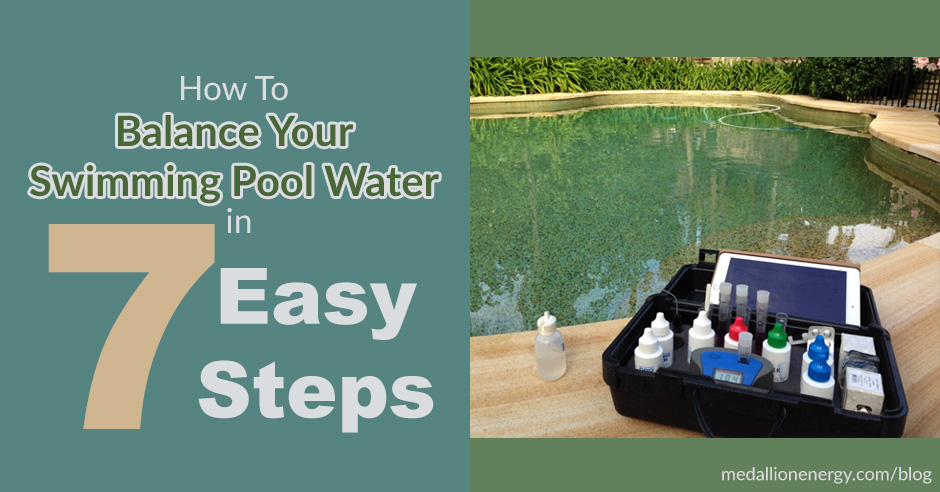Trying to figure out how to balance pool water and adjust chemicals?
Keep reading, this guide explains it all
Most of the challenge in balancing a swimming pool comes down to knowing which chemicals to use, and how much of them. But it’s definitely a worthwhile challenge.
With proper pool water chemistry, chemicals work more effectively, lasting longer and saving you money.
Of course, it’s called balancing your water for a reason. Because with swimming pools, each chemical can affect how another behaves. So it’s important to understand the relationships between them.
Sometimes a chemical might be too high, and other times, too low.
But how do you adjust pool chemicals? And when?
In this post, we explain how to balance your pool water and adjust chemicals with ease. And you’ll learn how to do it in 7 easy steps.
But before we start, here’s a quick summary of how to balance pool water:
Pool Chemical Startup List
- Adjust Total Alkalinity
- Ideal range: 80 – 120 ppm
- Adjust pH
- Ideal range: 7.4 – 7.6
- Balance Calcium Hardness
- Ideal range: 200 – 400 ppm
- Add sanitizer (chlorine, bromine, or biguanide)
- Ideal range: 3 ppm (chlorine)
- Measure Total Dissolved Solids
- Ideal range: Less than 2,000 ppm
- Shock the pool
- Test the water
So now that you’ve got the idea of it, let’s go through the process step by step.
Download a free Pool Chemical Levels Chart at the end of this post!
How To Balance Your Pool Water in 7 Easy Steps
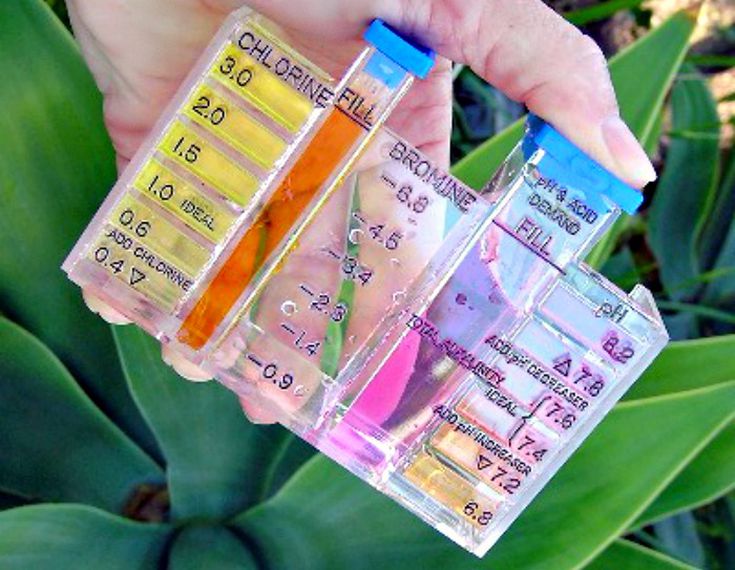


Although it’s not an included step, it’s assumed that you do an initial test of your water before adjusting chemicals.
1.) Test and adjust Total Alkalinity
Your pool’s Total Alkalinity represents the number of alkaline substances present in the water.
Every swimming pool should have a healthy amount of alkaline in it. Why?
Because alkaline is a pH stabilizer. So when your pool’s alkaline is properly adjusted, your pH fluctuates less.
Ideal Total Alkalinity range: 80 – 120 ppm
How to increase total alkalinity:
- Use sodium bicarbonate, or baking soda to increase total alkalinity.
- Use up to 25 pounds of sodium bicarbonate per 10,000 gallons of pool water.
How to decrease total alkalinity:
- Use sodium bisulfate (dry acid)
- Use muriatic acid
When using dry acid to decrease total alkalinity, follow the numbers in this chart from our friends at Pinch-a-Penny:
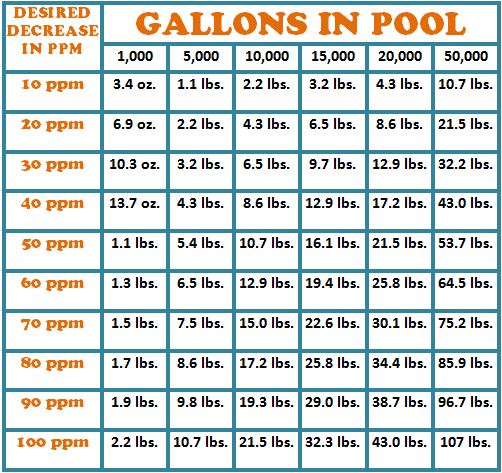


2.) Test and adjust pH
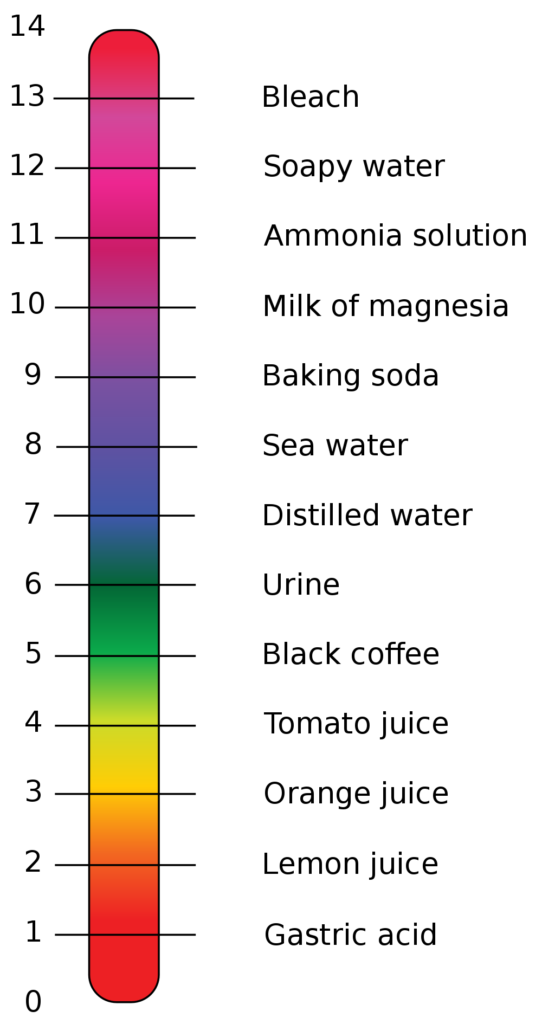


pH measures how much of an acid or base a substance is. It’s measured according to a scale that ranges from 1.0 to 14.0.
On the pH scale: 0 to 7.0 covers the acidic range, while 7.0 to 14 covers basic.
Depending on what levels you get during your initial water test, you may have to increase or lower your pH.
Ideal pool pH level: 7.4 – 7.6
How to increase pH:
Adding a pH increaser, like sodium carbonate (soda ash), can raise and stabilize your pH level.
As a point of reference: 6 oz of soda ash will raise a 10,000 gallon pool’s pH by .2
If you notice your pH level fluctuating, your alkalinity might be too low. IF that happens to you, add baking soda to your water to increase alkalinity and stabilize pH.
How to decrease pH:
Use a pH decreaser like sodium bisulfate, or muriatic acid to lower your pool water’s pH.
3.) Measure and adjust Calcium Hardness



If you ever notice a while line or scaling around your pool’s water line, it’s probably calcium buildup. And how often you see it is directly related to your pool’s calcium hardness level.
Ideal Calcium Hardness level: 200 – 400 ppm
How to increase calcium hardness:
To increase your pool water’s calcium hardness use calcium chloride. Follow the usage instructions printed on the packaging.
How to decrease calcium hardness
- Partially drain your pool and refill it with fresh water.
- Use a flocculant to collect and vacuum excess calcium.
4.) Add sanitizer (chlorine) to your water
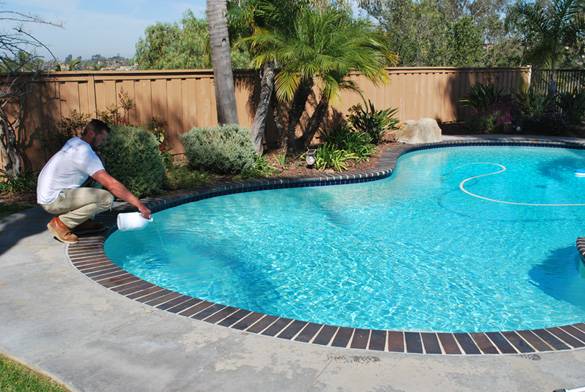


Sanitizer is what keeps your pool free of germs and bacteria. Without it, every pool would quickly become a breeding ground for germs.
But luckily, we use sanitizers like chlorine to keep the water safe and healthy.
When it comes to measuring chlorine, there are a few numbers to keep track of:
- Free Chlorine
- Measures the amount of unused, or available chlorine in the water
- Total Chlorine
- Measures the total amount of chlorine present in the water
To find your pool’s combined chlorine (used chlorine): subtract Total Chlorine from Free Chlorine
Ideal levels for chlorine: 3 ppm
Chlorine comes in a few forms:
- Chlorine tablets
- Granular chlorine (pool shock)
- Liquid chlorine
- Salt chlorine generator
For this step, you can save time and shock your pool now. This gives you a jump start on refreshing the water and takes care of sanitizing your pool.
A few other pool sanitizers:
Bromine
Bromine is similar to chlorine and doesn’t give off the strong odor. It’s gentler on the skin, but more often used in smaller pools and spas since it’s pricier.
While a great chlorine alternative, bromine is unstabilized and therefore not ideal for outdoor use since it gets easily burned away by the sun.
Healthy pool bromine levels range from 3 ppm to 5 ppm
Biguanide
Biguanide is part of a chemical sanitization trio. For this reason, it cannot be used with traditional pool algaecides, shocks, and other chemicals.
Since biguanide must be used with other companion chemicals, it’s more expensive than regular chlorine.
Proper levels for biguanide: 30 to 50 ppm
Minerals
Mineral systems aren’t as common as the aforementioned sanitization methods, but they’re still used. Especially as supplements to traditional sanitizers like chlorine or salt generators.
Systems like the Zodiac Nature 2 works by releasing copper and silver ions into your water, which help to regulate pH.
Manufacturers of mineral systems recommend replacing the mineral cartridge every 6 months. Other than that, mineral systems are pretty low maintenance.
5.) Check and adjust Cyanuric Acid
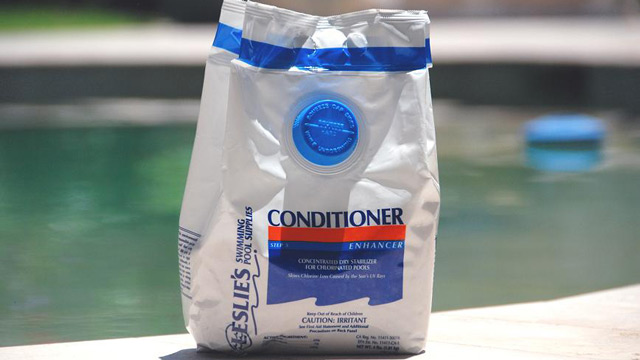



This chemical acts as sunblock for chlorine, protecting it from easily burning up under the sun’s intense UV rays.
Usually, you can find a small amount included in pool shock. But odds are, you’ll still need to add some to your water to get it in the right range.
The ideal level for cyanuric acid is between 30 and 50 ppm.
6.) Measure your water’s Total Dissolved Solids
Do you ever wonder happens to all the chemicals and substances that you add to the water? The pool shock, salts, algaecides, dirt, and pretty much everything else.
How come all of that stuff never piles up in your pool? Where does it go?
Well, it turns out, it does pile up. And there’s a special number to measure it:
Total dissolved solids.
This number represents how many of those substances have dissolved in your water.
It’s regular for your pool to have a TDS level of a few hundred or so, even 1,000.
But there does come a point when a pool’s TDS level is too high, and the only effective solution is draining and replacing water.
If your pool’s TDS level is below 2,000 ppm, then no adjustments are needed.
However, if TDS levels rise above 2,000 ppm, then begin draining the pool in small increments. With each drain, replace with fresh water. Keep testing until TDS levels are under 2,000 ppm.
How the Langelier Saturation Index affects your pool water balance
While every pool owner benefits from maintaining proper chemical levels, there’s one major factor to consider when balancing your water:
Temperature.
Temperature affects how well pool chemicals work. Or rather, their effectiveness.
Which is why the Langelier Saturation Index exists. The LSI is a calculation produced by a special formula that indicates how corrosive or scale prone water is.
More importantly, it also helps you determine how much to scale your pool chemical balancing by with respect to temperature.
Luckily, the folks at OrendaTech put together a great chart that makes calculating your LSI super easy:
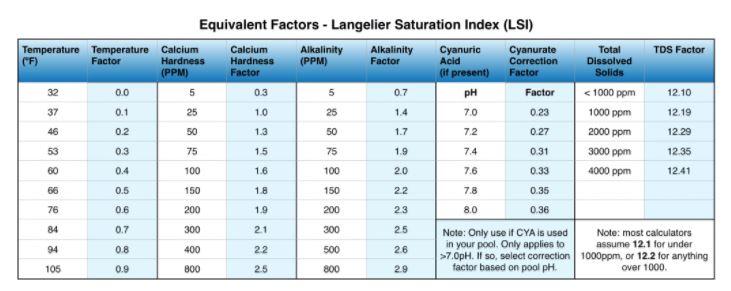


Use this equation and number provided in the above chart to calculate LSI:
(pH) + (Temperature Factor) + (Calcium Hardness Factor) + [(Alkalinity Factor) – (CYA correction factor @ current pH)] – (TDS factor) = LSI
Here’s an example, with an imaginary swimming pool:
- ph: (7.4)
- Temperature: 94ºF (Temperature Factor = 0.8)
- Calcium hardness: 200 (Calcium Hardness Factor = 1.9)
- Alkalinity: 200 (Alkalinity Factor = 2.3)
- Cyanuric acid: @ pH 7.4 (Cyanurate Correction Factor = 0.31)
- Total dissolved solids: 1000 (TDS Factor = 12.19)
Here are the calculations:
[(7.4) + (0.8) + (1.9) + [(2.3)-(0.31)] – (12.1) = LSI
[(10.1) + (1.99)] – (12.19) = LSI
12.09 – 12.19 = LSI
-0.1 = LSI
7.) Shock your swimming pool




If you didn’t already shock your pool earlier during the sanitization step, now is the time.
To shock your pool, follow these steps:
- Fill a 5 gal bucket with warm water
- Slowly mix in one pound (bag) of pool shock
- Use a stick to stir the bucket and dissolve the shock
- Gradually pour the mixed bucket of shock water into the pool
- Pour most of it from the deep end so that it reaches your main drain faster
Related: How To Shock Your Pool
Test the water again
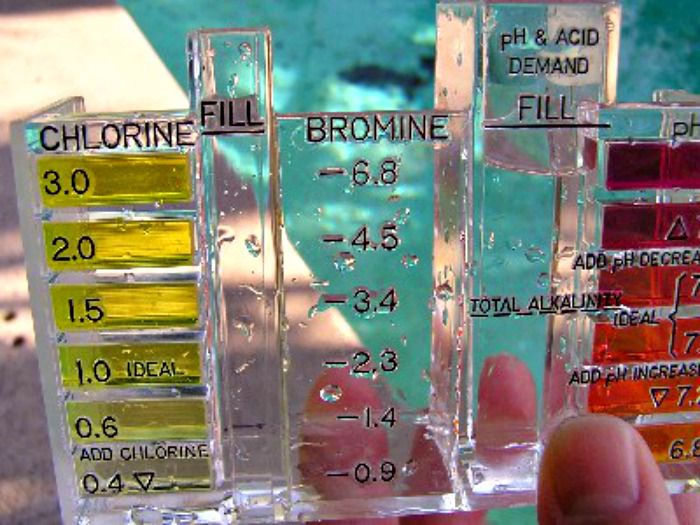


The last step: checking how well you balanced your water. Before breaking out the test kit, wait at least 6 hours after shocking your pool.
Then, grab your pool water checklist and running down the list and check your levels.
You might need to make a few small adjustments, and that’s fine. You’re better off correcting chemical imbalance earlier rather than later.
If you need a quick reference for setting the right levels, download our free Pool Chemical Levels Chart below
Balance pool water with a Pool Chemical Levels Chart
Balancing your pool is easy when you know all the right steps. If you followed along with this post, then you should now have a perfectly balanced pool.
But if you’re more of a visual learner, or just want some reference material then you’re in luck.
Fill out the quick form below to download a free Pool Chemical Levels Chart to use for adjusting chemical levels. With all the information you need on one page, you’ll save a bunch of time and balance your pool twice as fast.
If you liked this post, you might also like:

